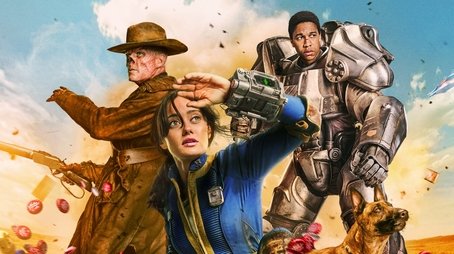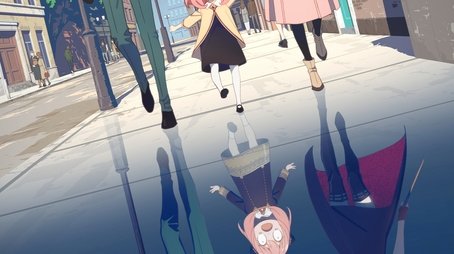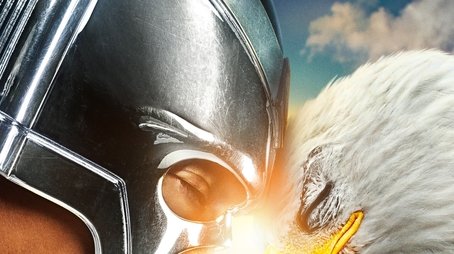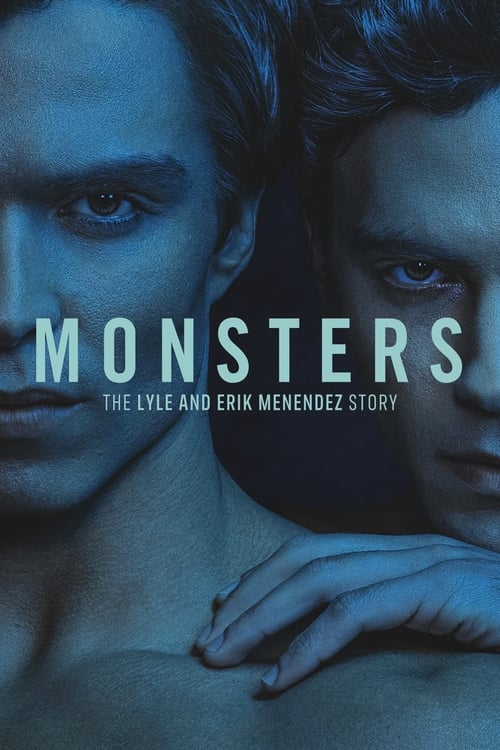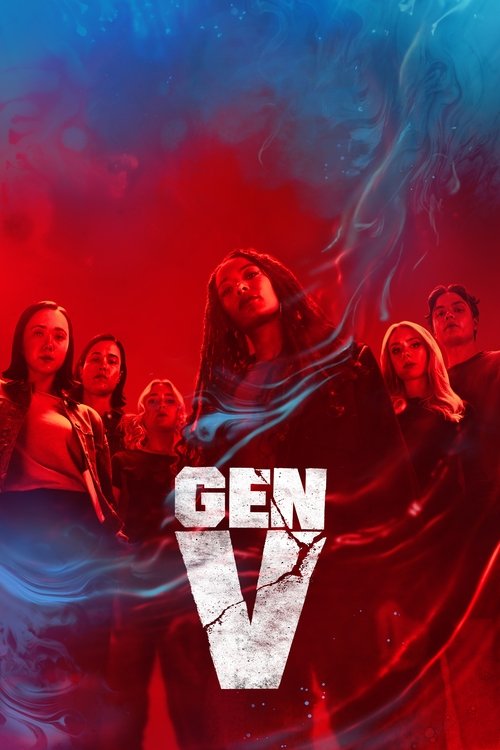
Ask Your Own Question
What is the plot?
The series begins in the year 2296, 219 years after the Great War of 2077, which was a nuclear exchange between the United States and China that devastated the planet. The story opens inside Vault 33, an underground fallout shelter where Lucy MacLean has lived her entire life, sheltered from the radioactive wasteland above. Lucy's life changes dramatically when her father, Kyle MacLean, is kidnapped by a group of ruthless wasteland raiders. Determined to find him, Lucy decides to leave the safety of Vault 33 and venture into the dangerous surface world of post-apocalyptic Los Angeles.
Upon emerging from Vault 33, Lucy encounters the harsh realities of the wasteland: radiation, mutated creatures, and hostile human factions. Early in her journey, she meets Maximus, a squire of the Brotherhood of Steel, a militant faction clad in power armor with a zealous belief in restoring civilization through technology. Maximus is on his own mission but agrees to accompany Lucy for mutual benefit. Together, they navigate the treacherous terrain, facing threats from raiders and other hostile groups.
As Lucy and Maximus travel, they cross paths with Cooper Howard, a legendary ghoul bounty hunter with a mysterious past. Cooper's appearance is marked by disturbing, decayed flesh, a result of radiation exposure, and he carries the aura of a spaghetti-western antihero. Cooper's motivations are complex; he is neither fully villainous nor heroic, and his past is gradually revealed through flashbacks. Lucy, Maximus, and Cooper form an uneasy alliance, each driven by their own agendas but united by the common goal of survival and uncovering the truth behind the wasteland's chaos.
The trio's journey leads them to confrontations with various factions, including the Brotherhood of Steel, raiders, and other survivors who view vault dwellers like Lucy as privileged and disconnected from the harsh realities of the surface. Along the way, Lucy learns more about Vault-Tec, the corporation responsible for building the vaults and conducting sociological experiments on their inhabitants. This revelation deepens the mystery surrounding her father's disappearance and the true purpose of the vaults.
In a pivotal sequence, Lucy and her companions infiltrate a raider stronghold to rescue her father. The raid is tense and violent: they stealthily approach the compound, neutralize guards one by one, and engage in a firefight when discovered. Cooper's combat skills and Maximus's Brotherhood training prove crucial in overcoming the raiders. They successfully free Kyle, but the escape is fraught with danger as more raiders pursue them through the irradiated ruins. The group narrowly evades capture by using the terrain and their knowledge of the wasteland to their advantage.
Following the rescue, Lucy confronts her father about his involvement with Vault-Tec and the vault experiments. Kyle reveals that he was part of a secret project to monitor and manipulate vault dwellers for Vault-Tec's purposes. This disclosure shakes Lucy's trust and forces her to reconsider her understanding of her family and her own identity. Meanwhile, Maximus prepares for an impending war between the Brotherhood of Steel and rival factions vying for control of the wasteland's scarce resources.
The season's climax centers on a large-scale battle between the Brotherhood of Steel and a coalition of raiders and wasteland survivors. Maximus leads the Brotherhood forces, employing power armor and advanced weaponry, while Lucy and Cooper provide critical support by sabotaging enemy supply lines and gathering intelligence. The battle is brutal and chaotic, with heavy casualties on both sides. Lucy faces a key decision when she discovers that Vault-Tec has a weapon capable of mass destruction; she must choose whether to use it to end the conflict or destroy it to prevent further devastation.
Lucy ultimately decides to destroy the weapon, believing that humanity's survival depends on cooperation rather than annihilation. This choice leads to a fragile truce among the factions, but the future remains uncertain. The season ends with Lucy, Maximus, and Cooper standing together, looking out over the wasteland, each contemplating the challenges ahead and the possibility of rebuilding civilization.
Throughout the series, flashbacks and character interactions reveal the broader history of the Great War, the rise of Vault-Tec, and the sociopolitical dynamics of the post-apocalyptic world. The narrative balances action sequences, such as the raid and the battle, with character-driven moments that explore themes of trust, identity, and survival in a fractured world.
What is the ending?
In the 2024 TV series "Fallout," the ending revolves around Lucy's journey to uncover the truth about her family and Vault-Tec. She learns that her father, Hank, was responsible for the destruction of Shady Sands, leading to her mother becoming a Ghoul. Lucy mercy-kills her mother and joins forces with The Ghoul to track down Hank, who escapes with a Brotherhood of Steel mech suit. The finale sets the stage for Season 2, with Lucy and The Ghoul heading towards New Vegas to uncover the truth behind Vault-Tec's plans.
Now, let's delve into the ending in a more detailed narrative:
The climax of the series unfolds with Lucy discovering the shocking truth about her father, Hank. It is revealed that Hank was not born in a vault as he claimed but was involved with Vault-Tec. His actions led to the destruction of Shady Sands, a city that was home to over 30,000 people. This revelation comes as a devastating blow to Lucy, who had been searching for answers about her family's past.
As the story progresses, Lucy's mother, Rose, is shown to have become a Ghoul due to Hank's actions. In a poignant moment, Lucy decides to end her mother's suffering, showing mercy in a world filled with violence and despair. This act signifies Lucy's growth and her ability to make difficult choices in the face of overwhelming circumstances.
Meanwhile, Maximus, a key figure in the Brotherhood of Steel, leads an assault on the New California Republic (NCR), successfully capturing the Observatory and gaining control of its cold-fusion reactor. Moldaver, a leader of the NCR, dies during the attack, but not before revealing crucial information about Lucy's family.
Hank, who had been imprisoned, escapes during the chaos by commandeering one of the Brotherhood's mech suits. This escape sets the stage for Lucy's next journey, as she decides to track down her father with the help of The Ghoul. The Ghoul, who has a past connection with Hank, offers Lucy a lifeline, suggesting they work together to uncover the truth behind Vault-Tec's plans.
The finale concludes with Lucy, The Ghoul, and his companion heading towards New Vegas, symbolized by the iconic Hollywood sign now lit up in the post-apocalyptic landscape. The final scenes also show Hank standing before the ruins of Las Vegas, hinting at his involvement in the events that will unfold in Season 2.
As for the fate of the main characters, Lucy is now on a path of discovery and vengeance, driven by her desire to understand her family's past and the secrets of Vault-Tec. The Ghoul becomes her unlikely ally in this quest. Hank, on the other hand, is positioned as a major antagonist, heading towards New Vegas with unclear intentions. Norm, Lucy's brother, is left trapped in Vault 31, where he had uncovered secrets about their family's role in the vaults. The Brotherhood of Steel, led by Maximus, emerges as a powerful force in the wasteland, setting the stage for future conflicts.
Is there a post-credit scene?
The TV show Fallout (2024) does not have a traditional post-credits scene after its final episode in Season 1. Instead, the credits sequence itself includes an animated outro that provides important context: it shows Hank MacLean walking toward a distant city on the Wasteland horizon, which is identified by a sign during the credits as New Vegas, a key location in the Fallout universe. This visual serves as a narrative bridge and sets up anticipation for the second season, rather than a separate post-credits scene.
The credits highlight the progression of the world and hint at the evolving state of the Mojave Wasteland, emphasizing that the story will continue to explore new developments in Season 2, rather than picking up directly from one of the many possible game endings. There is no additional live-action or bonus scene after the credits roll in Season 1.
What is the significance of Lucy MacLean's relationship with her father Cooper Howard in the story?
Lucy MacLean discovers that her father, Cooper Howard, is a genocidal corporate figure who has become a ghoul. This revelation freezes her emotionally and leads to a violent confrontation involving Hank and others. Ultimately, Lucy disowns Cooper and gives her mother a mercy killing, aligning her with The Ghoul as they prepare to confront Vault-Tec's current leadership, setting up key dynamics for Season 2.
Who is Lee Moldaver and what is her role in the conflict involving Vault 32 and Vault 33?
Lee Moldaver is a complex character who was present before the bombs fell and is alive post-apocalypse. She invented cold fusion and had her company bought by Vault-Tec. Moldaver takes over Vault 32 and invades Vault 33 with raiders to kidnap Hank and attack the inhabitants. Her motivations are tied to revenge against Hank for nuking Shady Sands, but many details about her deception and plans remain unexplained.
What is the nature of Hank's character and his actions throughout the series?
Hank is a pivotal character who wears robot armor and is involved in violent confrontations, including attacking Lucy and others. He disapproves of Moldaver's actions and has a history of retrieving children and nuking Shady Sands. Hank is freed from captivity by Maximus and immediately dons a suit of armor, indicating his readiness for further conflict.
What mysteries remain about the Enclave and Vault-Tec's plans as revealed in Season 1?
The Enclave is mentioned briefly, with Wilzig escaping from them, but their role is unclear since they were mostly wiped out 50 years prior. Wilzig's base contains super mutant corpses and Vault-Tec's cold fusion technology, suggesting Vault-Tec's ongoing plans for post-apocalyptic genocide. The Enclave does not actively pursue Wilzig in Season 1, leaving their intentions ambiguous.
How are the characters Lucy MacLean, Norm MacLean, and The Ghoul portrayed in terms of personality and development?
Lucy MacLean is portrayed as skilled but not superhuman, learning and adapting through experience. Norm MacLean, her brother, is cynical and fearful initially but grows more nuanced and brave. The Ghoul, aka Cooper Howard, is depicted with morally ambiguous traits in a spaghetti-western style, with flashbacks revealing the history of the vaults and nuclear war, adding depth to his character.
Is this family friendly?
The TV show "Fallout" produced in 2024 is not family-friendly due to several potentially objectionable or upsetting scenes and aspects. Here are some details:
-
Violence and Gore: The series includes frequent and graphic violence, with scenes of characters being shot, stabbed, and beaten. There are instances of dismembered body parts, blood splatter, and detailed injuries. Characters are shown being crushed or blown up, though these scenes are often brief or off-screen.
-
Disturbing Content: The show features mutated creatures and humans with disturbing features, which may shock some viewers. There is a scene where a character stabs a corpse and eats a piece of flesh, though the mutilation is mostly off-screen.
-
Sexual Material: While limited, there are some sex scenes and sexual themes, though they are not graphic. Most sexual references are intended to be humorous and awkward.
-
Language and Profanity: The series contains strong foul language, including heavy swearing.
-
Alcohol, Drugs, and Smoking: Characters consume alcohol, and there are scenes of smoking, including children training to be soldiers smoking cigarettes.
-
Frightening Scenes: The show includes sudden loud noises, flashing lights during explosions, and scenes that might be frightening or intense, such as underwater drowning scenes and the skeletal remains of a child.
-
Emotional Content: There are scenes of screaming and intense emotional distress, which might be upsetting for sensitive viewers.

